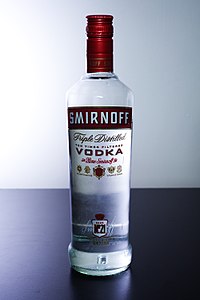 Smirnoff Red Label vodka | |
| Type | Distilled alcoholic beverage |
|---|---|
| Country of origin | Poland, Russia, Sweden[1][2] |
| Region of origin | Central, Northern and Eastern Europe |
| Alcohol by volume | 35–40% |
| Proof (US) | 70–80° |
| Color | clear |
| Ingredients | Water, grains |
| Related products | Flavored vodka, nalewka |
Vodka (Polish: wódka [ˈvutka]; Russian: водка [ˈvotkə]; Swedish: vodka [vɔdkɑː]) is a clear distilled alcoholic beverage. Different varieties originated in Poland, Russia, and Sweden.[1][2] Vodka is composed mainly of water and ethanol but sometimes with traces of impurities and flavourings.[3] Traditionally, it is made by distilling liquid from fermented cereal grains and potatoes since the latter was introduced in Europe in the 18th century. Some modern brands use corn, sugar cane, fruit, honey, and maple sap as the base.
Since the 1890s, standard vodkas have been 40% alcohol by volume (ABV) (80 U.S. proof).[4] The European Union has established a minimum alcohol content of 37.5% for vodka.[5][6] Vodka in the United States must have a minimum alcohol content of 40%.[7]
Vodka is traditionally drunk "neat" (not mixed with water, ice, or other mixers), and it is often served freezer chilled in the vodka belt of Belarus, Estonia, Finland, Iceland, Latvia, Lithuania, Norway, Poland, Russia, Sweden, and Ukraine.[3] It is also used in cocktails and mixed drinks, such as the vodka martini, Cosmopolitan, vodka tonic, screwdriver, greyhound, Black or White Russian, Moscow mule, Bloody Mary, and Caesar.
- ^ a b "The History of Vodka". Proof.
- ^ a b The Art of Distilling, Revised and Expanded: An Enthusiast's Guide to the Artisan Distilling of Whiskey, Vodka, Gin and other Potent Potables. Quarry Books. January 2019. ISBN 9781631595554.
- ^ a b Herlihy, Patricia (2012). Vodka: A Global History. Reaktion Books. p. 12. ISBN 9781861899293.
- ^ Evseev, Anton (21 November 2011). "Dmitry Mendeleev and 40 degrees of Russian vodka". Science. Moscow: English Pravda.Ru. Retrieved 6 July 2014.
- ^ "The Production of Vodka". Archived from the original on 22 January 2008. Retrieved 20 January 2007.
- ^ Cite error: The named reference
europarlwas invoked but never defined (see the help page). - ^ "United States Code of Federal Regulations Title 27, Section 5.22(a)(1)". United States Government Printing Office. Archived from the original on 23 November 2011. Retrieved 31 May 2011.